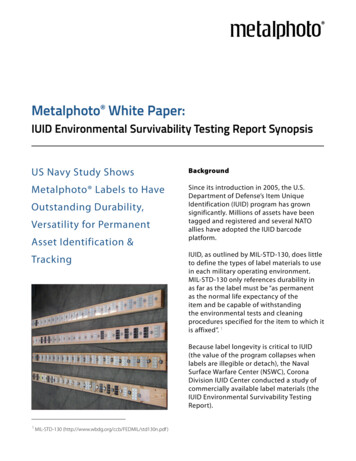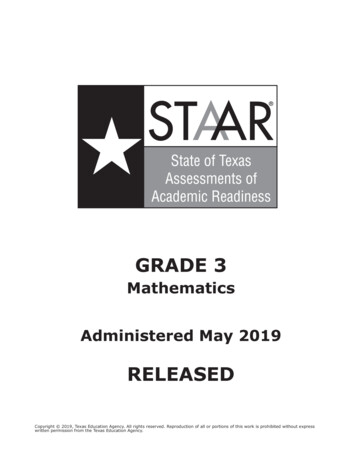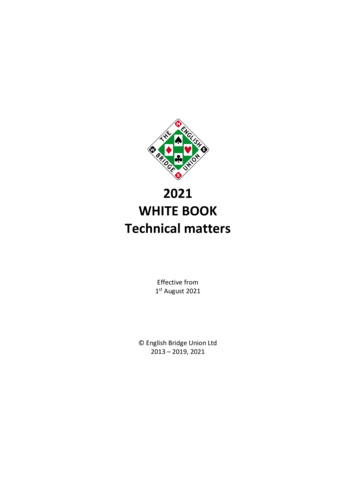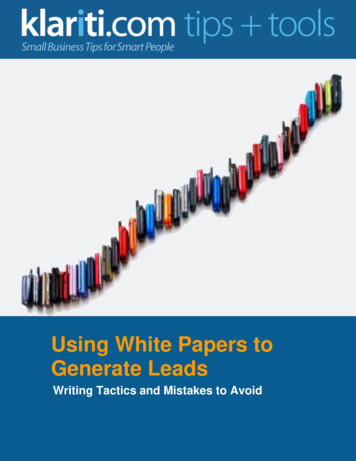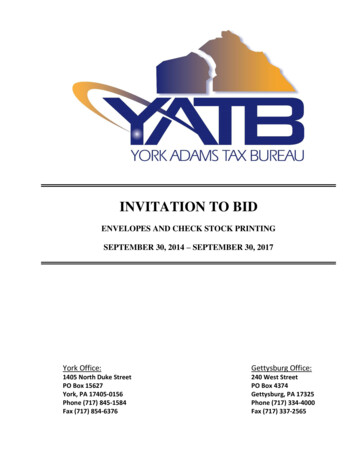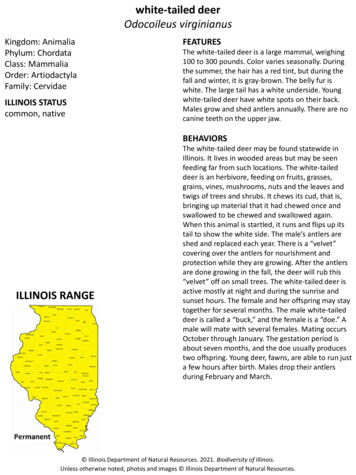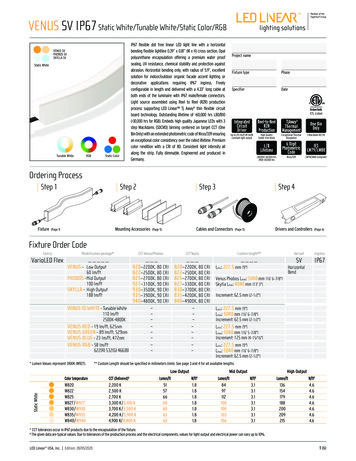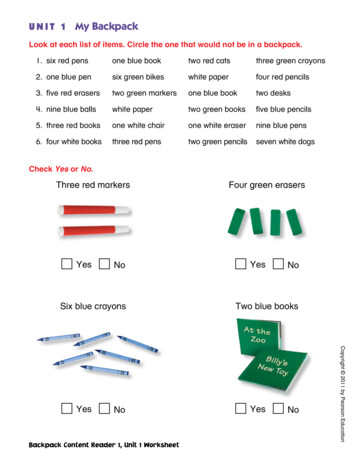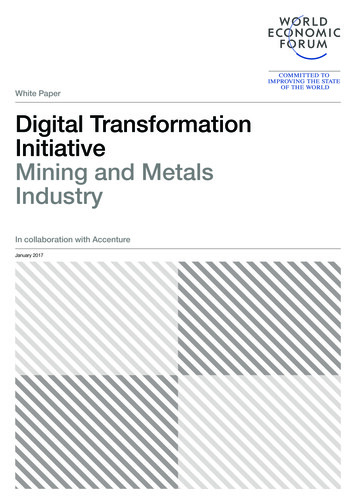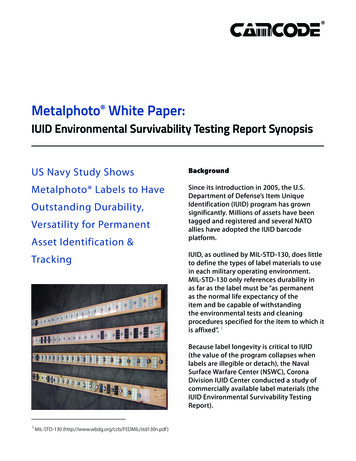
Transcription
Metalphoto White Paper:IUID Environmental Survivability Testing Report SynopsisUS Navy Study ShowsBackgroundMetalphoto Labels to HaveSince its introduction in 2005, the U.S.Department of Defense’s Item UniqueIdentification (IUID) program has grownsignificantly. Millions of assets have beentagged and registered and several NATOallies have adopted the IUID barcodeplatform.Outstanding Durability,Versatility for PermanentAsset Identification &TrackingIUID, as outlined by MIL-STD-130, does littleto define the types of label materials to usein each military operating environment.MIL-STD-130 only references durability inas far as the label must be “as permanentas the normal life expectancy of theitem and be capable of withstandingthe environmental tests and cleaningprocedures specified for the item to which itis affixed”. 1Because label longevity is critical to IUID(the value of the program collapses whenlabels are illegible or detach), the NavalSurface Warfare Center (NSWC), CoronaDivision IUID Center conducted a study ofcommercially available label materials (theIUID Environmental Survivability TestingReport).1MIL-STD-130 (http://www.wbdg.org/ccb/FEDMIL/std130n.pdf )
2CamcodeThe Report offers an unbiased, governmentsponsored comparison of label durabilityin order to help project managers identifythe best label material for their operatingenvironment(s). This paper outlines theresults of the Report as they pertain toMetalphoto , the material that earnedmore high scores than any other evaluated(Figure 1).OneAbrasion (26)100%Corrosion (26)100%Temperature (26)100%Chemical (26)100%96%Chipping (26)91%Shear (11)TwoTest Phase (# Materials Evaluated)% Materials Metalphoto Performs As Good Or BetterPressure Wash (44)100%Weather/UV (42)100%Chipping (47)100%87%Chemical (47)0%10%20%30%40%50%60%70%80%90%100%Note: scores based upon percentage of materials that Metalphoto performs as good or better.Metalphoto scores are taken from multiple submissions in Phase One and Phase Two.Chemical tests are aggregated across all substances evaluated, shear & peel tests combine HSE/LSE/CARC/temp.Figure 12Study DesignThe Item Unique Identification (IUID)Environmental Survivability Testing Reportwas conducted in two phases: the firstpublished in August 2011 and the secondin September 2012. The second phasewas implemented in order to incorporateseveral new tests and label materials. Inparticular, adhesion to CARC paint, elevatedtemperature adhesion, UV exposure,pressure washing and new chemicalexposure tests were added in phase two.Across both phases 73 label materialswere evaluated in 38 simulated operatingenvironments (Figure 2).2Item Unique Identification (IUID) Environmental Survivability Testing Report, Naval Surface Warfare Center, Corona Division IUID Center
3CamcodeSimulated EnvironmentsLaboratory Test ConditionsSunlight/Weather ExposureExposure to sunlight in California desert conditions for 6 months (Feb-Aug)AbrasionTaber Abraser, CS17 with 1kg wheel load as per ASTM D4060Chipping50 ft. gravel drop; modified ASTM D3170 and ASTM D2794 standard testsShear/Peel StrengthLabels were peeled (flexible materials) / sheared (rigid materials) at a set angleat a constant rate while measuring the force, modified ASTM D3167. Adhesiontests were performed on three surfaces: glass, polypropylene, and CARC, atroom temperature and 110 F.Temperature ExposureLabels were exposed for one week to high temperatures (160 F 5 F) and coldtemperatures (-40 F 5 F). Peel/shear tests were conducted at 24 hours, 72 hoursand one week.Pressure WashingA 2 gallon per minute pressure washer limited to 1,200 pounds per square inch(psi) as required by US Marine Corps Technical Manual, TM 4795-OR/1A; totaldetachment or edge lifting was recorded.Chemical ExposureImmersion for 10 1 minutes and 7200 60 minutes (5 days 1 hr) as per MILSTD-810 Method 504. Sixteen chemicals were evaluated.Salt-Spray/CorrosionMIL-STD-810 method 509.5 and ASTM B117.Across all tests the Microscan UID DPM Compliance verifier was used to measure Unused Error Correction (UEC) after the test exceptpressure washing where detachment or edge lifting was recorded.Figure 2The 73 materials were submitted by 18 companies. Submissions can be grouped into thefollowing categories (Figure 3):Material# of SubmissionsBase MaterialPolymers (Polyesters, Acrylates, etc.)51PlasticPhotosensitive Anodized Aluminum (Metalphoto, BlackPlus)14Anodized AluminumCeramic coated stainless steel2SteelDirect part marked stainless steel1SteelCoated anodized aluminum (DuraBlack)5Anodized AluminumFigure 3All submitted labels contained informationabout the material and a 2D data matrixbarcode required for IUID. Labels wereevaluated using a Microscan UID DPMCompliance verifier to the AIM-DPM-1-2006standard. Using the verifier (vs. humanobservation) has the advantages of beingboth objective (quantitative, measured bya machine) and the established militarystandard for an acceptable barcode markunder MIL-STD-130.
4CamcodeThe 10 Metalphoto labels submitted variedby adhesive (3M 9485, 3M 9469, 3M 9672LE and CARC adhesive), laminate (none vs.SandShield) and marking method (pre-printvs. YAG laser marked). It is important tokeep in mind when considering Metalphotothat it can be customized with adhesivesspecifically suited to the bonded surface/application or laminates that enhance itschemical or abrasion resistance. As a rawmaterial (vs. a pre-adhesive applied system),Metalphoto can be configured into a varietyof customized label systems to addressvariety of surface energies and overallapplications.subsequent testing. In terms of pre-testverification, Metalphoto labels rose to thetop due to the high-resolution capabilityof the material. Because Metalphoto isa photographic substrate, it is ideal forhigh-detail, small labels on small surfacessuch as guns, sights and communicationequipment. Additionally, Metalphoto’sresolution allows for micro print andother anti-counterfeit measures to beincorporated into existing labels andnameplates (Figure 4).Initial VerificationPrior to each tests, all labels were verified.Verification was used as a baseline forAverage Unused Error Correction Prior to TestingIK13 - TT705A1.00IK12 - TT7011.001.00HO11 - Metalphoto CA10 - Metalphoto With SandShield1.00FL10 - mFOM Holder U07530RB-A11.00IK14 - TT7301.00WC13 - 310519401.00WC14 - 320510400.99PO10 - NSWC000050.99FC10 - 310510400.99WC11 - 310510400.990.99HO10 - Metalphoto AN13 - 320510400.99WC12 - 310510410.99AN14 - 320510410.99IK15 - TT7400.99AN12 - 310519400.99CA11 - Metalphoto With SandShield0.99AN11 - 310510410.99WC15 - 320510410.99FC13 - 320519400.990.99IK11 - TT700AN15 - 320519400.99IM11 - L32031580.99IK10 - TT4620.98ME10 - Craftmark0.98WC10 - 310510400.980.97PT10 - HG-2515PKHO13 - DuraBlack With Topcoat0.96FC12 - 310820400.960.96AN10 - 310510400.96FC14 - 910510400.96HO14 - BlackPlus 0.96FC15 - 910510400.94HO12 - DuraBlack 0.94AB13 - 3M 78470.93CA15 - BlackPlus 0.93ES12 - DuraBlack 0.91ES11 - B-4230.91FC11 - 310820400.88AB12 - UV High Resist0.86CA13 - DuraBlack With SandShield0.82CA12 - DuraBlack With SandShield0.75CO13 - Cable Marker0.75CA14 - BlackPlus With Laminate0.74CO12 - Cable Marker0.51ID10 - Dot Peen on Stainless Steel0.00Figure 40.100.200.300.400.500.600.700.800.901.00
5CamcodeFindings – ChippingMost labels failed with 6,500 ml or lessgravel. Plastic labels were most subjectto failure. However, a handful of labelsstood out. In particular, Metalphoto withSandShield dominated the phase tworesults, surviving after 14,092 ml of gravel 2,291 ml more than the next best material(Figure 5).Labels were subject to a 50 foot drop ( 40mph) of gravel in ever increasing amountsfrom 500 ml up. Labels were verified aftereach round and failure was the volume ofgravel to reduce the UEC to zero.Chipping Test Results (ml of gravel prior to failure)14,092CA11 - Metalphoto With SandShield11,80111,556WC11 - 310510408,4428,388CO13 - Cable 0WC12 - 31051041FC15 - 91051040WC15 - 32051041WC14 - 32051040CA14 - BlackPlus With LaminateHO12 - DuraBlack HO10 - Metalphoto FC12 - 31082040AN15 - 5003,5003,5003,5003,500WC10 - 31051040IM11 - L3203158IK14 - TT730HO14 - BlackPlus ES12 - DuraBlack AN13 - 32051040AN10 - 500IK13 - TT705AIK11 - TT700FL10 - mFOM Holder U07530RB-A1AB13 - 3M 7847500PO10 - re 5Findings – Pressure WashRigid substrates like Metalphoto andDuraBlack stood up extremely well topressure washing - across both of highsurface energy (HSE) and low surfaceenergy (LSE) surfaces. In fact, Metalphotoand DuraBlack rigid 0.020” labels with 3M9485 adhesive scored better than any othermaterial tested. According to the Report,“Rigid labels tended to perform better inpressure wash than flexible labels. Greaterlabel thickness and label rigidity reducesthe tendency of the label to start peeling.”(Figure 6)
6CamcodeTop performers were all Metalphoto or DuraBlack rigid labels.Figure 6Findings – Adhesion (Peel/Shear Tests)Findings – Weather TestsAll rigid 0.020” thick Metalphoto labels weretested with a shear test vs. the peel testconducted on the flexible plastic labels.As such performance can’t be comparedbecause the test methods vary. That saidMetalphoto labels exhibit 30-118 lbs/in ofadhesion strength. According to the Report,“High shear strength correlated well withpressure wash results. Rigid labels tendedto perform better in pressure wash thanflexible labels. Greater label thickness andlabel rigidity reduces the tendency of thelabel to start peeling.”Weather – the cycling of UV-radiation, highto low temperatures, humidity and rain – isa common cause of label failure. Phase twoincorporated a 6 month (February – August)weather test in the southern Californiadesert. Over that period researcherscalculated that the labels were exposedto 4367 MJ/m2 (mega joules per metersquared) of total solar radiation, equivalent45 cycles of MIL-STD-810G Method 505.5procedure II accelerated testing with aweatherometer.Although this 6 month period wasn’tenough to differentiate label performance(all labels were verifiable at the end),
7Camcodedegradation was seen in three label types:CO13 (Cable Marker Thermoplastic fromCodeSource), AB12 (UV High Resist Polyesterfrom A2B Tracking Solutions) and IK10 (TT462Polyimide Permanent Acrylic from Identco).Findings – Chemical ExposureIn the second phase Labels were subject toa set of 13 chemicals intended to representthe likely substances labels will come intocontact with (in phase one, Acetic Acid,Hydraulic Fluid and MIBK were tested).Labels were immersed in or coated witha chemical of interest and observed after10 minutes and 7,200 minutes (5 days) ofexposure.Metalphoto tested in the top 90% of alllabels evaluated. When protected with theSandShield overcoat, Metalphoto holds upto bleach better than Metalphoto alone;despite the durability of Metalphoto’saluminum oxide coating, Metalphoto issusceptible to bleach. It is recommendlimiting Metalphoto tags’ exposure tobeach or employing SandShield, Teflon orother liquid shedding agents to minimizeexposure.DuraBlack (another Horizons ISG product)performed the best out of any materialevaluated. DuraBlack is at multi-layer coatedaluminum for use with a CO2 laser. AlthoughDuraBlack does exceptionally well on thechemical tests, it’s shortcomings on othertests, namely UV exposure and chipping,make Metalphoto a better all around label.DuraBlack is typically used for short term(8-10 year) installation when labels must beproduced on-site or in-theater.In some cases failure was attributed toadhesive detachment. As a rigid material,Metalphoto can be attached mechanicallywith rivets. See the Metalphoto AttachmentGuide for more information on attachmentoptions (Figure 7).1. Sunlight/weather exposure test; 2. Abrasion test;3. Chipping test; 4. Shear/peel strength test;5. Temperature exposure test; 6. Pressure wash test;7. Chemical exposure test; 8. Salt-spray/corrosion test
8CamcodeAverage Chemical Performance100%DuraBlack Multi-Layer Coated Anodized Aluminum with Laminate (CA13)100%31082040 Polyester (FC11)95%DuraBlack Multi-Layer Coated Anodized Aluminum with Water-Based Liquid Topcoat (HO13)DuraBlack Multi-Layer Coated Anodized Aluminum (HO12)95%DuraBlack Aluminum (ES12)95%Metalphoto Photosensitive Anodized Aluminum (HO11)93%UV High Resist Silver Polyester (AB12)93%93%BlackPlus Exterior Grade Black Anodized Aluminum (HO14)91%DuraBlack Multi-Layer Coated Anodized Aluminum with Laminate (CA12)Cable Marker Thermoplastic (CO12)89%Cable Marker Thermoplastic (CO13)88%86%31051040 Polyester (WC10)31051940 Polyester (AN12)86%HG-2515PK Polyethylene terephthalate (PET) (PT10)86%B-423 Polyester (ES11)86%BlackPlus Exterior Grade Black Anodized Aluminum with Laminate (CA14)86%91051040 Polyimide (FC15)86%91051040 Polyimide (FC14)86%31051040 Polyester (FC10)86%32051940 Polyester (AN15)86%32051041 Polyester (AN14)86%32051040 Polyester (AN13)86%31051041 Polyester (AN11)86%31051040 Polyester (AN10)86%Craftmark Polyester (ME10)85%32051041 Polyester (WC15)85%32051040 Polyester (WC14)85%31051940 Polyester (WC13)85%31051041 Polyester (WC12)85%Metalphoto Photosensitive Anodized Aluminum (HO10)85%Metalphoto Photosensitive Anodized Aluminum with Laminate (CA10)85%TT740 Polyester (IK15)85%TT730 Polyester (IK14)85%85%TT700 Polyester (IK11)84%Metalphoto Photosensitive Anodized Aluminum with Laminate (CA11)31082040 Polyester (FC12)83%Metal Plate #4 Mechanical Polish 304 Stainless Steel (ID10)82%82%L3203158 White Gloss (IM11)81%TT701 Polyester (IK12)81%32051940 Polyester (FC13)80%31051040 Polyester (WC11)80%mFOM Holder U07530RB-A1 Polyvinylidene Fluoride (FL10)78%3M 7847 Acrylate (AB13)TT705A Polypropylene (IK13)78%NSWC00005 Polyester (PO10)77%74%BlackPlus Exterior Grade Black Anodized Aluminum with Laminate (CA15)62%TT462 Polyimide (IK10)0%10%20%30%40%50%60%70%80%90%100%Reported score is the average out of scores normalized to 100.Figure 7Salt Fog CorrosionSalt fog corrosion testing did notdifferentiate the materials.Taber AbrasionAbrasion testing was conducted with two1kg weights for up to 2,500 cycles. AllMetalphoto labels scored in the top 1/7th ofthe labels tested with the fewest amountof error corrections required. Subsequenttesting indicates Metalphoto to beextremely abrasion resistant withstandingup to 8,000 cycles on a Taber Abraser.TemperatureAlthough no significant differences betweenthe labels were observed at the 160 Fand -40 F temperatures tested. However,Metalphoto can withstand exposure totemperatures up to 1,000 F which is why thematerial is specified for labeling aluminumingots and on-engine and aerospace tags.
9CamcodeConclusionMetalphoto earns the highest possiblescore on 32 of 33 tests for which it wasgiven – more top scores than any othermaterial evaluated – making it an excellentchoice for a wide variety of operatingenvironments. Further, because Metalphotois available in thickness from 0.003” to0.125” and can be paired with any adhesiveor mechanical attachment method (unlikemany plastic labels with pre-appliedadhesive), it can be customized create alabel system that can survive a variety ofmilitary and industrial applications.Metalphoto’s durability comes from itsphotographic image which is sealedinside of the anodized aluminum,providing resistance to corrosion,sunlight degradation, abrasion, extremetemperatures and chemical exposure.The purpose of the Navy’s tests are toidentify materials that fit the needs ofvariety of programs, applications andcombat environments. Although thereis no material that dominates every test,Metalphoto photosensitive anodizedaluminum did emerge as the best optionfor more application environments than anyother material. Because real-world usageconditions are often unknown when a labelis specified and applied, it is important topick a material that will be strong in manyenvironments. As such, the recent Coronastudies confirm that Metalphoto remainsone of the most durable and versatileidentification materials available.About Metalphoto:About Camcode:For over 50 years, industrial and military engineershave specified Metalphoto photosensitive anodizedaluminum in applications where permanent productidentification is critical.Founded in 1979, Camcode is your single sourcefor a full range of automatic identification and datacapture (AIDC) solutions. Camcode’s Metalphoto barcode labels have been trusted to provide permanentand durable asset identification that lasts a lifetime.Metalphoto’s durability comes from its photographicimage which is sealed inside of the anodizedaluminum, providing resistance to corrosion,sunlight degradation, abrasion, extremetemperatures and chemical exposure.Metalphoto is produced by Horizons ImagingSystems Group, an internationally recognizedmanufacturer of printable aluminum technologies.Employing a range of processes, the company’sstate-of-the art manufacturing lines are located inCleveland, Ohio, USA.Camcode also provides a vast array of assetmanagement services to help you track your assetsand gain productivity and accountability within yoursystem.Through project management, ISO 9001:2008certified processes and AIDC solutions, ourexperienced team is committed to helping youimprove your business processes through assettracking.For more information, visitwww.camcode.com or call 800-627-3917.
Identification (IUID) program has grown significantly. Millions of assets have been tagged and registered and several NATO allies have adopted the IUID barcode platform. IUID, as outlined by MIL-STD-130, does little to define the types of label materials to use in each military operating environment. MIL-STD-130 only references durability in

